2025 Harvest Recap: the Tortoise Crosses the Finish Line
Last Tuesday, with small clean-up picks of Grenache, Cinsaut, and Counoise and one recalcitrant lot of Bourboulenc (more on that later) we completed the 2025 harvest. This was the 11th week of harvest, which was our longest in more than two decades and our second-longest ever.
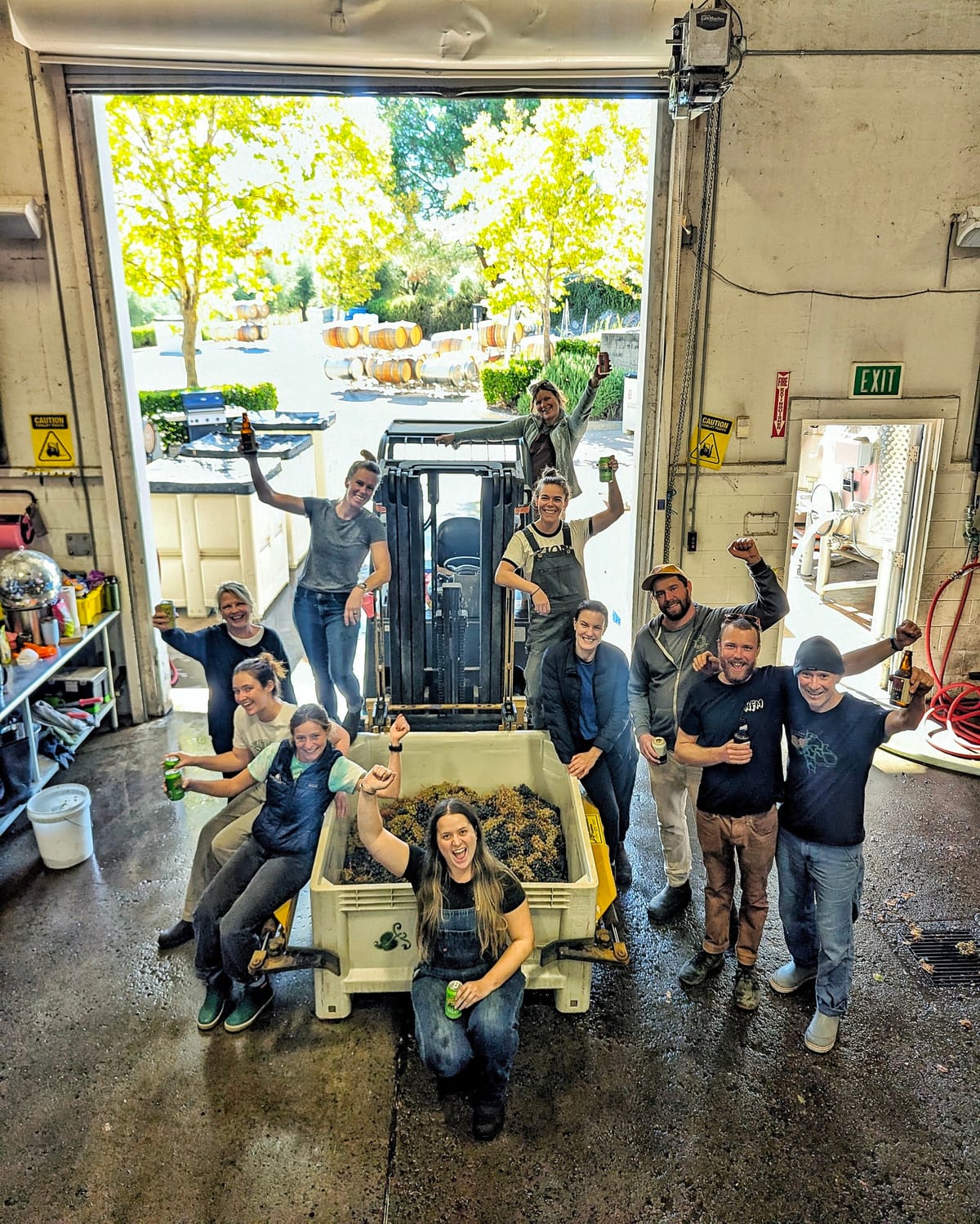
Last Tuesday, with small clean-up picks of Grenache, Cinsaut, and Counoise and one recalcitrant lot of Bourboulenc (more on that later) we completed the 2025 harvest. This was the 11th week of harvest, which was our longest in more than two decades and our second-longest ever. In the chart below, orange bars are our estate lots, while blue represents purchases for the Patelin or Lignée programs:
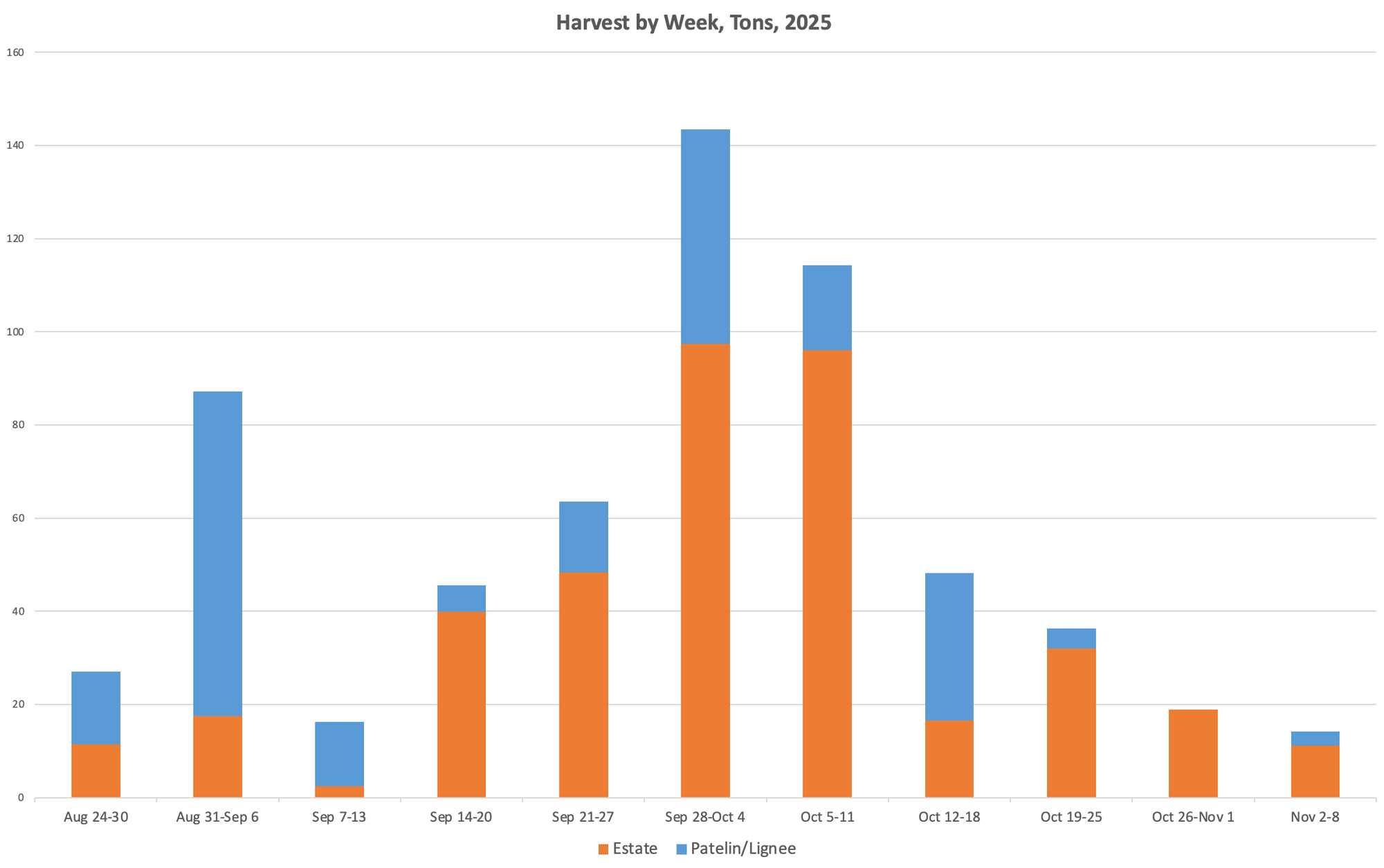
The primary things we'll remember about 2025 will be the exceptionally moderate summer (with the fewest 100°F days in our history here) and the two unusually early rain events, one on September 24th and one on October 14th, that forced a scramble before to pick what was ready and a temporary pause after. In the end, both were followed by sun and dry weather that allowed the fruit to reconcentrate, and we were able to bring in nearly everything. That included an experimental lot, harvested from all the mother vines around our tasting patio and our new demonstration block, that provided a striking image the last day in the cellar:

I've shared a version of this heat accumulation graph in a few blogs this year. But I will share it again to bring you up to date. 2025 is the solid orange line. You can see that we were hovering around average – and actually warmer than 2024 – until late June. Our unusually cool mid-July brought us below the long-term average, though never as far below as we were in 2023. A relatively warm August caught us up a bit toward the norm, but cool weather in early September and again around our rain event in mid-October brought us to where we finished, having accumulated about 5% fewer degree days than average:
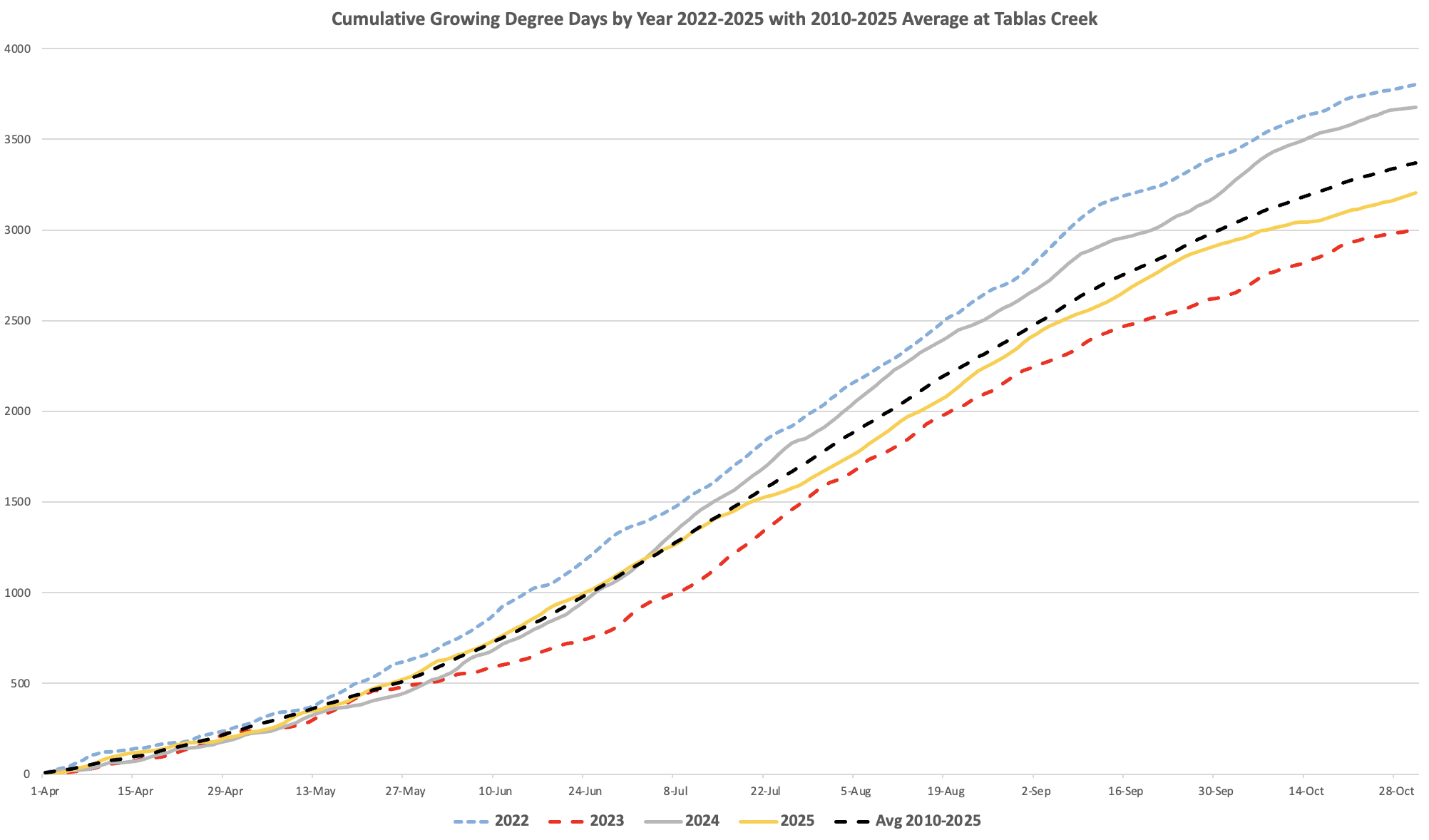
Another way of looking at the year is going month by month compared to normal. We started the year with a relatively cool April (but no frost nights) and a relatively warm May (but no 100°F days). Then cooler-than normal June and July led into a warm August (but again, very few 100°F days). Finally, a cool September and October kept the pressure off and we could bring our grapes in bit by bit:
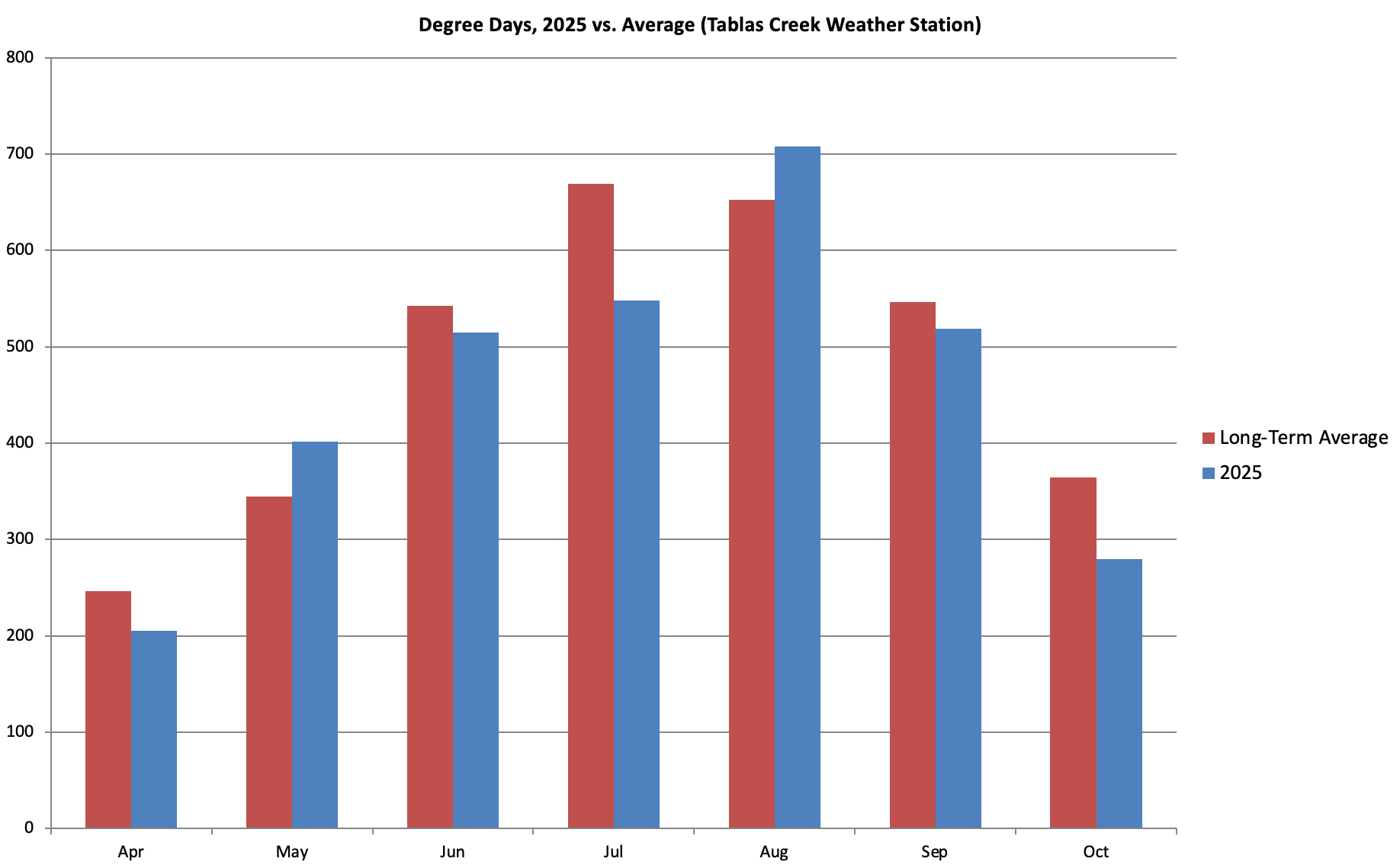
Despite our somewhat drier than average 2024-25 winter we saw above-average yields, almost across the board:
| Grape | 2025 Yields (tons) | 2024 Yields (tons) | % Change vs. 2024 |
| Viognier | 14.4 | 7.9 | 82.3% |
| Marsanne | 11.0 | 7.9 | 39.2% |
| Grenache Blanc | 30.5 | 24.7 | 23.5% |
| Picpoul Blanc | 7.4 | 6.3 | 17.5% |
| Vermentino | 18.1 | 14.4 | 25.7% |
| Bourboulenc | 5.9 | 4.5 | 31.1% |
| Roussanne | 34.5 | 23.7 | 45.6% |
| Other whites | 5.9 | 4.4 | 34.1% |
| Total Whites | 127.7 | 93.8 | 36.1% |
| Grenache | 114.7 | 76.5 | 49.9% |
| Syrah | 45.9 | 47.6 | -3.6% |
| Mourvedre | 53.7 | 37.8 | 42.1% |
| Tannat | 11.0 | 14.4 | -23.6% |
| Counoise | 21.8 | 14.8 | 47.3% |
| Cinsaut | 5.0 | 3.6 | 38.9% |
| Other reds | 6.9 | 8.1 | -14.8% |
| Total Reds | 259.0 | 202.8 | 27.7% |
| Total | 386.7 | 296.6 | 30.4% |
While the overall tonnage is our second-most ever (narrowly trailing 2017) the new blocks that we have in production (mostly head-trained, dry farmed plantings on Jewel Ridge) mean that our 3.07 tons/acre is actually right at our 20-year average of 3.08 tons/acre. Most encouraging to me is the success of three late-ripening, low-vigor grapes: Mourvedre, Counoise, and Roussanne, all of which saw yields improve by at least 40%. I am encouraged because it suggests that rather than some sort of sustained decline, it was the unrelenting heat that we experienced in 2024 that was most to blame for their reduced yields. Most worrying to me is that 114.7 tons of Grenache. I'm not worried about its quality – what we got looks terrific – but before this the most Grenache we've ever harvested was the 97.1 tons that we got back in 2023. This is a major jump from that, and we already had to be creative to figure out what to do with all that terrific Grenache that year. This year's blending is going to offer an even greater challenge. Still, there are worse problems to have than a large quantity of wine from a grape we love.
We had 134 harvest lots, an increase of three vs. 2024. These included eight more estate lots (96 instead of 88), one fewer Lignée lot (6 instead of 7, thanks to us being able to co-harvest and co-ferment some of the grapes we got from the Fenaughty Vineyard) and four fewer Patelin lots (32 vs. 36). Despite the relatively similar number of lots, the total quantity of fruit (615 tons) was about 15% more than last year, a reflection of our ability to find some larger lots and our decision to use more estate fruit for our Patelin wines than we have since 2020. Our full harvest chalkboard (below) is actually incomplete, as we're still looking for the best way to display the 14 lots that came in after we ran out of space on October 23rd:

The grapes that pushed out the harvest into those tenth and eleventh weeks fall into two camps. In one camp were the late-ripening varieties like Tannat, Counoise, and Mourvedre, which even as October wound down were still showing low sugars (around 20° Brix) and high acids (pH just above 3) that just encouraged us to be patient. Thankfully, conditions were good and we were able to get another degree or two of Brix and bring the pH levels up a touch. The second camp held some white grapes whose sugars were so low (in the high teens Brix) that even though pH levels were rising we didn't feel great about bringing them in. Those grapes included Roussanne, Picardan, Terret Noir, and the Bourboulenc lot that I mentioned in the opening paragraph. We've had that issue before with Roussanne, but the other grapes were new additions to this list. We ended up getting those grapes to 20°-21° Brix, and think they'll be solid additions to our program, but we'll keep these lots separate and evaluate them in the spring.
One other way that you can get a quick assessment of a vintage is to look at average sugars and acids. Since 2015, our average degrees Brix and pH at harvest:
| Year | Avg. Sugars | Avg. pH |
| 2015 | 22.60 | 3.59 |
| 2016 | 22.04 | 3.71 |
| 2017 | 22.87 | 3.74 |
| 2018 | 22.80 | 3.62 |
| 2019 | 22.30 | 3.62 |
| 2020 | 22.14 | 3.62 |
| 2021 | 22.12 | 3.55 |
| 2022 | 22.14 | 3.70 |
| 2023 | 22.77 | 3.51 |
| 2024 | 22.25 | 3.69 |
| 2025 | 22.47 | 3.50 |
Despite those late lots where the pH numbers were creeping up, the average harvest pH was the lowest we've seen since 2011. That's a reflection of the cooler year, but also of the new blocks on Jewel Ridge which had great sugar and acid numbers. However, despite the low pH reading, our readings of titratable acidity (TA) were also low. We've seen this in previous harvest seasons where we got rain and aren't worried, though it did cause us to be even more cautious than normal about adding tartaric acid to some of the lower-acid lots. We'll address acid balance this year through blending. The year's sugar levels were more or less in the middle of our historic range.
Just because we've finished picking doesn't mean that we're done with our cellar work. There are still lots to be pressed off, tanks to be dug out, and fermentations to monitor. But we're also washing and putting away equipment for the year, like the destemmer and sorting table which were sitting on our crushpad today:
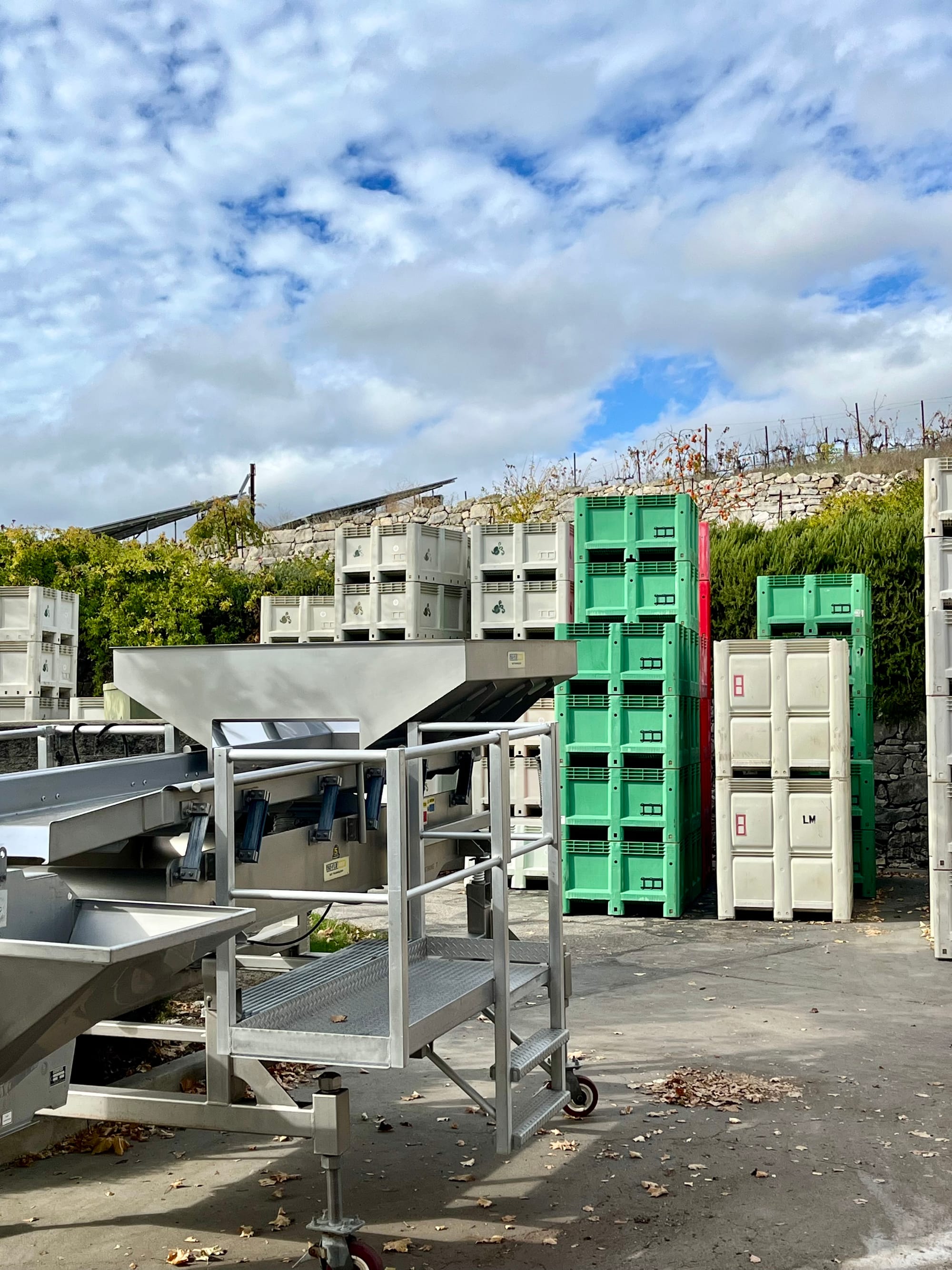
Now that the fruit is all in, it's welcome to start seriously raining any time. And it looks like we won't have long to wait. There's a winter storm coming tomorrow that looks like it could dump two or three inches on us by the weekend. The clouds were already starting to build up this morning to our west:
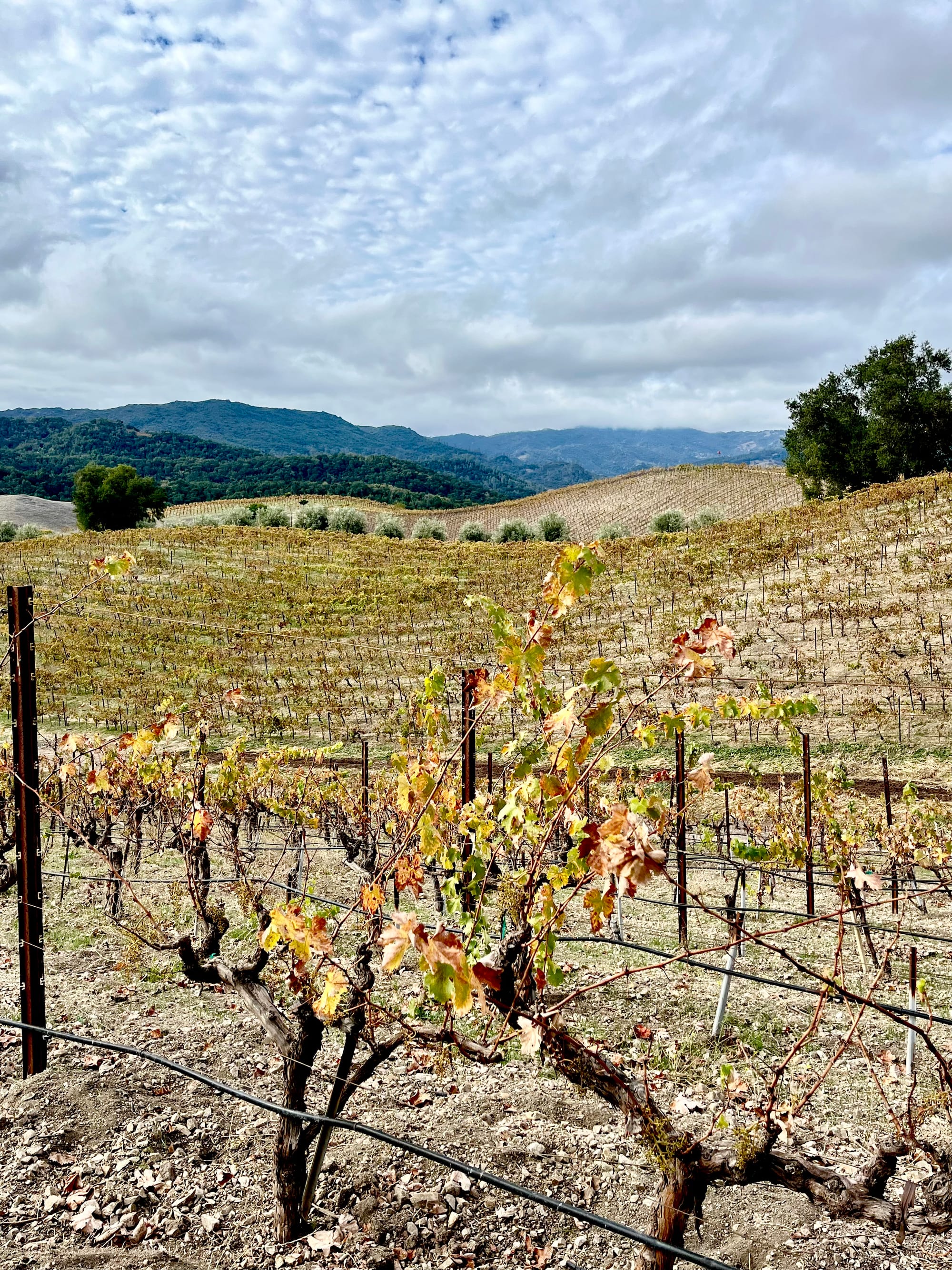
In preparation, we've been getting the vineyard ready for winter. We've tilled and seeded a few areas where we wanted to break up the soil, and seeded through last year's mat of grasses in other blocks. We're also laying out straw on our roads to minimize the risk of erosion (though that's less of a risk than many years because our early rain has already sprouted a carpet of green):

As soon as this storm passes, we'll get our flock of sheep back into the vineyard. We've already had dozens of lambs, with more on the way:
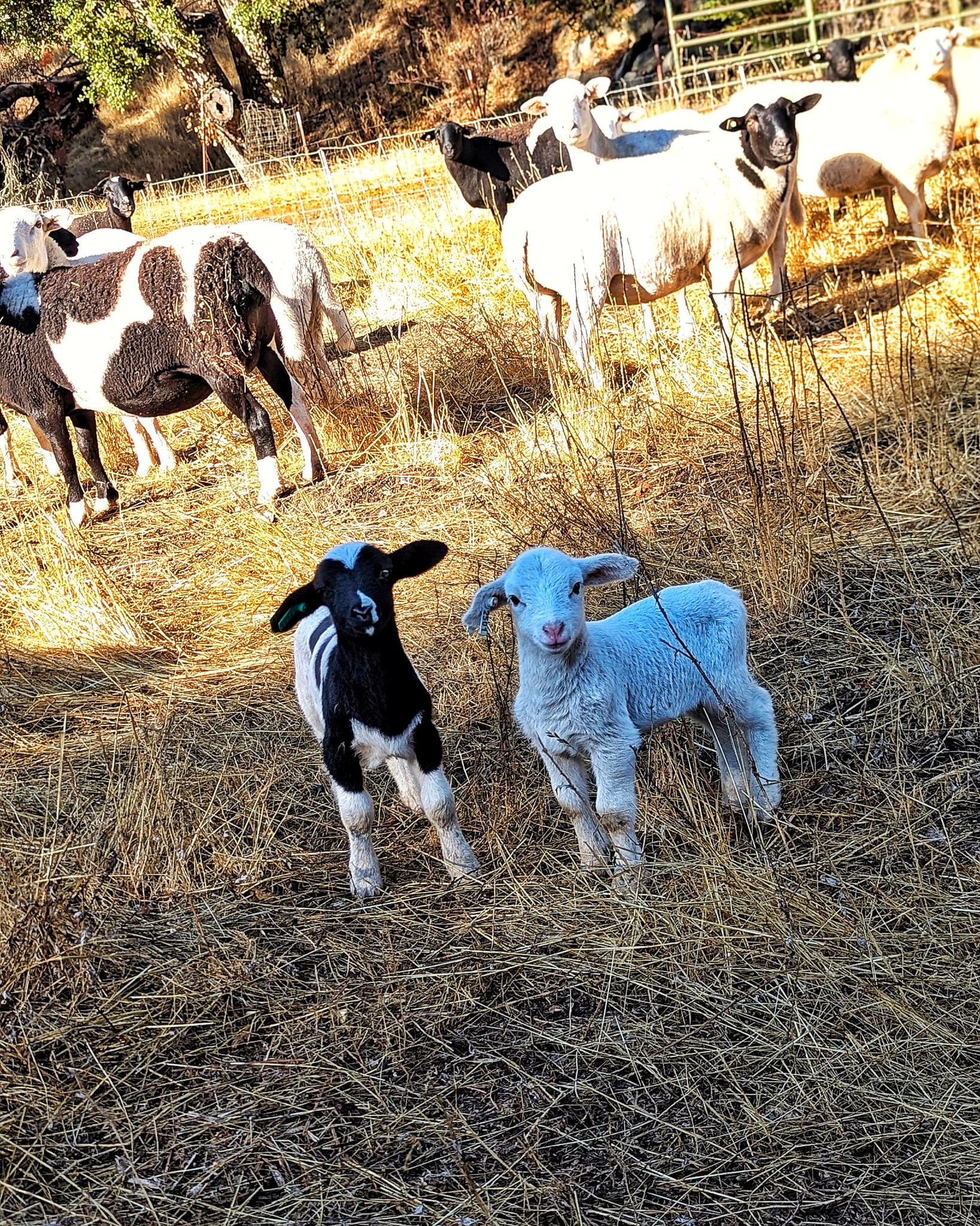
I asked Director of Vineyard Operations Austin Collins to share his thoughts on the 2025 vintage and he was tired but optimistic: "It was dramatically affected by the two rain events, which extended it out so long. Having lulls was bizarre for the whole crew. Having a year with low pH levels and low acids was a bit weird. But we're seeing good spice notes in the wines, especially the Mourvedre, which is some of the best I've tasted at this stage." We're all looking forward to getting to know the wines of 2025 even better in coming weeks.
It's always an adjustment coming down from the marathon that is harvest, especially in a year like this one. But we're all excited about what we're seeing so far and resting better knowing that the 2025 vintage is in the cellar, and as far as we can tell at this stage, looking good.

